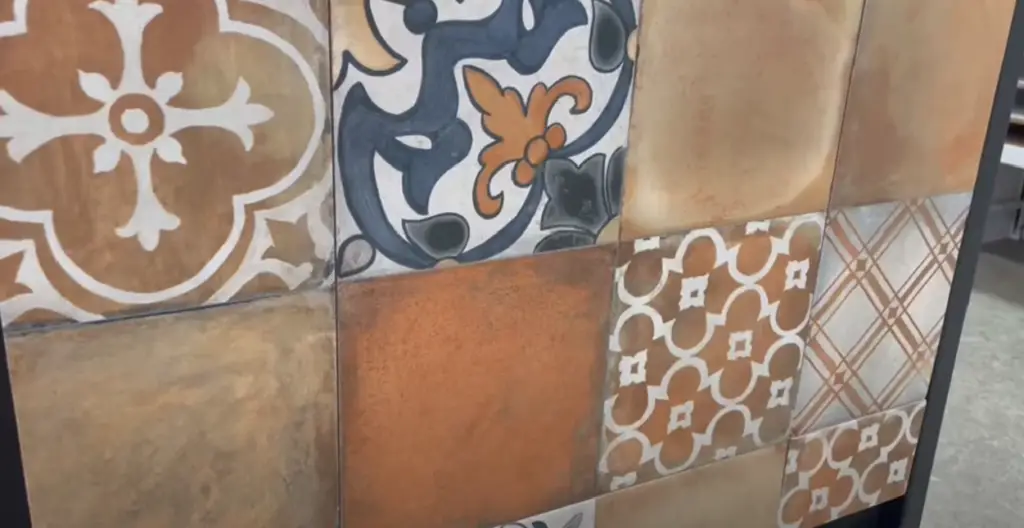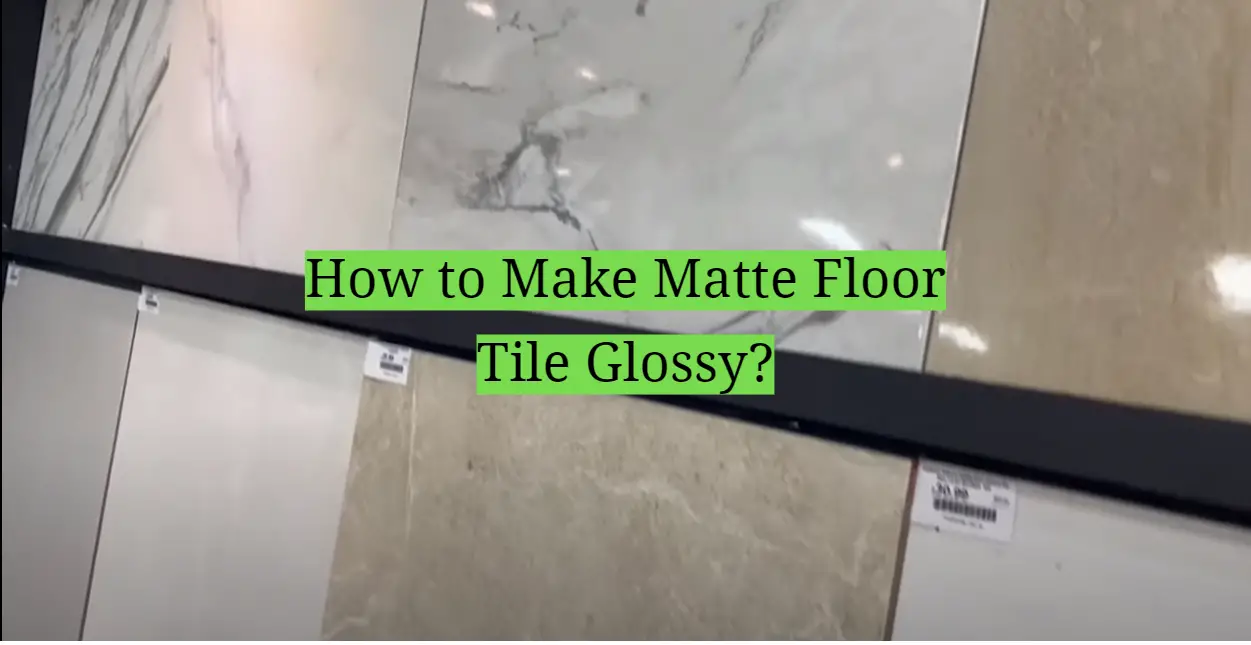Many homeowners choose matte floor tiles because of their non-slip surface and natural appearance, which makes them a popular option. However, over time, you may yearn for a change, preferring the shine and luster of glossy tiles. The good news is that you don’t need to replace your matte tiles to achieve this look. With the right materials and a bit of elbow grease, you can transform your matte floor tiles into glossy ones, infusing a touch of elegance and brightness into your space. This comprehensive guide will expertly guide you through the necessary steps to successfully achieve this transformation.
Comparing Matte Tiles and Gloss Tiles
Before embarking on the transformative journey, understanding the differences between matte and gloss tiles is of utmost importance. It is crucial to grasp the nuances and characteristics of each type, ensuring informed decisions when it comes to selecting the perfect tile for your needs. Matte tiles are renowned for their finish that minimizes reflection, offering a subdued and natural look. Their texture provides better grip, making them an ideal choice for bathrooms and areas with heavy foot traffic where slips may be a concern. However, they may be more prone to stain absorption than their glossy counterparts.

Gloss tiles, however, are characterized by their shiny, reflective surface. They bounce light around the room, making spaces seem larger and more luminous. As they are less porous than matte tiles, they resist staining and are easier to clean. However, their smooth surface can be slippery when wet, which is why they’re often used for walls, backsplashes, or low-traffic areas.
Benefits of Glossy Floor Tiles: Essential Information to Consider
Glossy floor tiles can dramatically enhance the aesthetic appeal of your space. Their characteristic shine imparts an elegant and sophisticated look, ideal for modern or minimalist interiors. A notable benefit of gloss tiles is their light-reflecting capabilities. By bouncing and diffusing light throughout the space, they have the power to enhance the brightness and spaciousness of a room. This property can be particularly beneficial in smaller or darker spaces that lack natural light.

Glossy tiles also offer a practical advantage in terms of maintenance. Their smooth, non-porous surface is resistant to stains and easier to clean, often requiring nothing more than a simple wipe to remove dust and spills. Furthermore, they can withstand harsh cleaning chemicals, making them an excellent choice for areas that require regular and thorough cleaning.
However, despite these advantages, one must also consider the potential drawbacks. The glossy surface can be slippery, particularly when wet, so caution is advised in rooms prone to moisture, such as bathrooms or kitchens. In addition, glossy tiles may show scratches and scuffs more easily than matte tiles, so they might not be the best choice for high-traffic areas or homes with pets.
In conclusion, while going glossy can promote brighter, cleaner spaces, balance these perks with the lifestyle and functional needs of your space.[1]
Things You’ll Need
- Broom or vacuum cleaner for initial cleaning
- Damp mop
- Tile cleaner or mild detergent
- Bucket for mixing cleaner
- Gloss sealer (available at home improvement stores)
- Paintbrush or roller for sealer application
- Gloves to protect your hands during application
- Cloth or mop for maintenance cleaning
- Gentle tile cleaner for maintenance.
How can I maintain the glossy appearance of matte floors?
Maintaining the glossy appearance of your newly transformed matte floor tiles involves regular cleaning and careful handling. Here are some steps you can follow:
Daily Cleaning: Sweep the floor daily with a broom with soft bristles or dust mop to remove dust and loose debris. This prevents the accumulation of dirt that can dull the tile’s shiny surface.
Weekly Mopping: Clean the floor using a moist mop every week. Minimize excessive water usage as it can seep into the grout lines and cause damage.

Prompt Spill Clean-Up: Whenever a spill occurs, clean it up immediately to prevent the liquid from staining the tile and dulling the glossy surface.
Use of Proper Cleaning Agents: Always use a gentle, non-abrasive cleaner to clean your glossy tiles. Certain chemicals can erode the gloss sealer, resulting in a lackluster appearance of your tiles.
Use of Soft Cleaning Tools: It is advisable to refrain from utilizing harsh or cleaning tools with abrasive properties like steel wool or harsh scrubbing brushes, as these can scratch the glossy surface.
Reapplying the Gloss Sealer: Depending on the wear and tear, you might need to reapply the gloss sealer every couple of years to maintain the high-shine finish.
Remember, the key to maintaining the glossy appearance of your floor tiles lies in regular and proper cleaning, coupled with periodic reapplication of the gloss sealer.[3]
Tips to Avoid Common Mistakes
While transforming your matte tiles into glossy ones can be an exciting process, there are a few common mistakes that you should endeavor to avoid to ensure a flawless finish.
Not Cleaning Tiles Properly Before Sealing: Before applying the gloss sealer, it is important to make sure that your tiles are completely clean. Any dust or grime can get sealed in, leading to a murky or uneven finish.

Applying Sealer on Wet Tiles: Ensure that your tiles are thoroughly dried before applying the sealer. Applying sealer on wet tiles can cause them to blister and peel off.
Applying Too Much or Too Little Sealer: The amount of sealer you apply matters. Too little might not give the desired gloss, while too much can make your tiles look overly shiny or create a build-up.
Not Allowing Adequate Drying Time Between Coats: It is always important to wait for the recommended drying time of the sealer before applying a second coat. This ensures optimal results and allows for proper adhesion and durability. Failure to do so can lead to a patchy finish.
Not Maintaining the Gloss: Once the gloss sealer has been applied, it is important to regularly maintain it to preserve its glossy finish. Failure to address this aspect can result in a gradual loss of luster in your tiles.
Using Harsh Cleaning Tools or Detergents: It is advisable to refrain from using harsh cleaning tools or harsh detergents on your glossy tiles. They can scratch the surface and eat away at the sealer, leaving your tiles looking dull.
By avoiding these common mistakes, you can enhance the longevity and beauty of your glossy floor tiles.
What are the disadvantages of matte finish tiles?
While matte finish tiles offer a sleek, sophisticated aesthetic and are less likely to show watermarks or smudges, they do come with a few potential disadvantages. One primary concern is that they may not reflect light as well as their glossy counterparts, which might make a room appear darker.

This means that spills need to be cleaned up promptly to prevent potential damage. Matte finish tiles also tend to show scratches more easily, and their texture can collect dust and require more regular cleaning. Finally, depending on the color and material, matte tiles may show wear and tear more prominently over time. Despite these potential drawbacks, many homeowners appreciate the modern look and non-slip surface that matte tiles provide.[5]
FAQ
How to make porcelain tiles shinier?
Making porcelain tiles shinier involves a few simple steps:
Clean the Tiles Thoroughly: Start by sweeping or vacuuming the tiles to remove loose dirt and debris. Then, mop the floor with a mild detergent mixed with warm water. Rinse thoroughly to make sure no detergent residue is left on the tiles.
Dry the Tiles: After cleaning, dry the tiles using a soft, absorbent towel to prevent water spots from forming. This is an important step as any water left on the surface can affect the application of the gloss sealer.
Apply a High-Gloss Tile Sealer: Choose a high-gloss tile sealer for porcelain tiles. Ensure to follow the instructions on the product label for the best results. Normally, you apply the sealer evenly over the tiles using a sponge or paintbrush, then let it dry for the recommended time.
Buff the Tiles: After the sealer is completely dried, you can enhance the shine by buffing the tiles. Use a soft cloth or a buffing pad and work in small sections, making circular motions.
Maintain Regularly: Regular cleaning and occasional reapplication of the sealer can keep your porcelain tiles looking shiny. Avoid using harsh chemicals for cleaning as they can dull the finish.
By following these steps, your porcelain tiles can maintain a beautiful, glossy shine that enhances the overall look of your space.
Do glossy tiles pose a slip hazard?
Glossy tiles can be slightly more slippery than matte tiles, especially when wet. It is crucial to exercise caution in areas that are susceptible to moisture, like bathrooms or kitchens. To reduce the chances of slips and falls, consider using a slip-resistant tile sealer or floor finish that offers extra traction. To prevent debris build-up and slippage, maintain a regular cleaning routine and promptly clean up spills.
What product is best for a glossy tile finish?
There’s a wide variety of gloss sealers on the market, but one of the top-rated products is the “Miracle Sealants Gloss Finish Sealer.” Known for its superior quality and durability, this sealer provides a high-gloss finish that is attractive and resistant to wear. Suitable for various tile materials like ceramic, porcelain, and natural stone. Another commendable product is “Aqua Mix Sealer’s Choice Gold,” renowned for its water-based formula that offers optimal performance and a desirable glossy finish. Always remember to follow the manufacturer’s instructions for best results. Whichever product you choose, ensure it meets your specific tile type and needs.[2]
How often should I reseal my glossy tiles?
In general, premium gloss sealers have the potential to endure for five years or even longer, contingent upon the level of foot traffic they encounter. However, it is advisable to reseal your tiles every couple of years or as soon as you notice some dulling in the tile’s shine. This will help maintain the glossy appearance and Maintain the pristine appearance of your tiles.
How remove scratches from tiles?
To remove scratches from your glossy tiles, you will need to use a mild abrasive like polishing powder or paste. Follow the instructions provided with the product and apply it in a circular motion using a soft cloth. Ensure that you do not over rub as it can potentially damage the glossy finish. If the scratches are still visible, it is advisable to consider consulting with a professional.
How to prevent my tiles from fading?
Tile fading is mainly caused by exposure to sunlight and can be prevented by using curtains or blinds. Additionally, it is crucial to use an effective sealer that prevents UV radiation from penetrating the tile surface and causing discoloration. Regularly clean your tiles with a gentle cleaner to maintain their best appearance for years to come. It is also important to clean up any spills promptly to prevent staining and dulling of the glossy finish.
How can matte floor tiles be made shinier effectively?
Making matte floor tiles shinier is a process that involves cleaning, sealing, and preserving the glossy finish. Begin by meticulously cleaning your tiles using a mild tile cleaner to eliminate all traces of dirt or grime. After the tiles are dry, apply a high-quality gloss tile sealer evenly over the surface, using a foam paint roller for larger areas and a brush for edges and corners. Allow the sealer to dry according to the manufacturer’s recommended drying time, and apply a second coat if necessary. Keep in mind that maintenance is key to maintaining the shine. Regularly clean your tiles with a non-abrasive cleaner and soft cloth, and avoid harsh detergents or cleaning tools that could scratch the glossy surface. Depending on the amount of foot traffic and wear and tear, you may need to reapply the gloss sealer every few years to maintain the glossy finish.[4]
How to remove stains from matte tiles?
Removing stains from matte tiles requires a few simple steps:
Identify the Type of Stain: Cleaning methods vary depending on the type of stain encountered. For example, organic stains (like wine or coffee) can usually be cleaned with hydrogen peroxide, while oil-based stains (like grease or lipstick) might require dish soap or degreaser.
Clean the Area: To effectively treat the stain, use a gentle cloth and warm water to cleanse the affected area from any superficial dirt or grime.
Apply a Cleaning Solution: Apply the appropriate cleaning solution (based on the type of stain) directly to the stained area. Leave the cleaner on the stain for the recommended amount of time.
Scrub the Stain: Gently scrub the stained area using a non-abrasive scrub brush or soft cloth. Be sure to scrub in a circular motion to fully lift the stain.
Rinse and Dry: Flush the region with warm water to eliminate any lingering cleaning solution, and then dry the tiles thoroughly with a soft cloth to prevent water spots from forming.
Remember, always test any cleaning solution on a small, hidden area of the tile first to ensure it won’t damage the finish. If the stain persists after cleaning, consult with a professional tile cleaner or consider replacing the stained tile.[6]
Can ceramic tiles be glossy?
Yes, ceramic tiles can indeed have a glossy finish. The glazing process, which involves applying a liquid glass coating and then firing the tile at high temperatures, creates a glossy finish. This process not only enhances the tile’s aesthetic appeal but also adds an extra layer of protection, making the tile resistant to stains, scratches, and moisture. Glossy ceramic tiles are commonly used in kitchens and bathrooms for their stylish look and easy maintenance.
However, it is important to note that glossy tiles can be slightly more slippery, especially when wet, so care must be taken when installing them in high-traffic or wet areas. Regular cleaning and maintenance will ensure that your glossy ceramic tiles retain their shine and look their best for many years to come.
Can you mix gloss tiles and matte tiles?
Mixing gloss and matte tiles is a viable design choice that can make your space more visually appealing. This combination not only adds texture but also creates a unique contrast that can enhance the overall aesthetic of a room. Glossy tiles can brighten up a space by reflecting light, while matte tiles can add depth and subtlety. When mixing these two finishes, it’s important to consider the functionality of the space. For instance, glossy tiles may be more suitable for walls or low-traffic areas, as they can be slippery when wet. On the other hand, matte tiles often make a safer choice for floors and high-traffic areas due to their non-slip properties. As always, personal preference and the overall design scheme should guide your decision.
Can you gloss the porcelain tile?
Yes, you can add gloss to porcelain tile. This is typically done by applying a tile sealer that adds a glossy finish. The process involves thoroughly cleaning the tiles, allowing them to dry, and then evenly applying the sealer using a foam paint roller or brush. It’s crucial to follow the manufacturer’s instructions regarding drying times and the need for additional coats. Remember that adding gloss to porcelain tiles will make them more slippery, especially when wet, so it’s not recommended for areas where slip hazards could be a concern. Regular cleaning and maintenance, including periodic reapplication of the sealer, will help maintain the glossy finish over time.[5]
Useful Video: Polished vs Matte Tiles! Which One is BETTER?
Conclusion
In conclusion, maintaining the look of both matte and glossy tiles requires careful and regular cleaning, the use of appropriate products, and prompt attention to stains and scratches. Whether you prefer the subtle elegance of matte tiles or the bright sheen of glossy tiles, understanding how to care for and maintain them can prolong their life and keep them looking their best. Remember, the key to a stunning tile floor is not just in the choice of tile but also in the proper maintenance and care. By following these guidelines, you can enjoy beautiful, glossy, or matte tiles in your home for years to come.
References:
- https://www.covertecproducts.com/how-to-make-matte-floor-tile-glossy-and-shiny-give-your-tile-floors-a-lasting-shine/
- https://repaintnow.com/make-matte-porcelain-tile-glossy/
- https://www.britishceramictile.com/blog/tile-shining-methods
- https://www.orientbell.com/blog/how-to-clean-matte-finish-tiles/
- https://www.novoceram.com/tiles/aspect/glossy
- https://floorvee.com/how-to-make-matte-tile-floor-glossy/














Leave a Reply